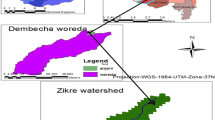Abstract
Status of organic carbon (C), total nitrogen (N), available potassium (K), calcium (Ca) and phosphorus (P) in three different depths (0–5 cm, 5–15 cm and 15–30 cm) on two hill slopes of 35% and 55% in orange orchard cultivated by the Mro tribe of Chittagong Hill Tracts (CHTs) were evaluated and compared with those in degraded bush forests, through digging three profiles in each land use. The content of all the five nutrients was found to be higher in the soil of orange orchard than in the soil of forest. But the variation was not consistent for both the slopes. The content varied depth wise also, having the highest value in surface soil in case of both the land uses on both the slopes. A mean available K content was significantly higher in orange orchard than in forest on 55% slope, while it was lower on 35% slope. Surface soil contained the nutrients of K and Ca with the amount of 0.2905-mg·g−1 soil and 3.025-mg·g−1 soil respectively in the orchard, while 0.1934-mg·g−1 soil and 1.6083-mg·g−1 soil were respectively in the forest. Organic carbon and total nitrogen were found more or less similar in surface soil on both the land uses showing a slight difference. Available P was found only in orange orchard, and in forest it was too little in amount to detect by the spectrophotometer. The degraded forests were poor in nutrient content due to high rate of soil erosion, which would be possible to be improved by bringing it under tree cover as proved by the adaptation of orange orchard there.
Similar content being viewed by others
References
Chowdhury, M.S.H. and Miah, M.D. 2004. Shifting Cultivation (Jhum) Practice by the Mro tribe in Thanchi Upazilla, Bandarban, Bangladesh. Jahangirnagar University Journal of Science, 27: 187–202.
Denniston, D. 1995. High Priorities: Conserving Mountain Ecosystems and Cultures. World Watch Paper-123. World Watch Institute, Washington D.C., U.S.A. p.80.
Gautam, I.P., Thapa, M.P., Gupta, K.P., et al. 2004. Cultivar Evaluation on Mango in Low Hills of Eastern Nepal. Nepal Net: An Electronic Networking for Sustainable Development in Nepal. National Agricultural Research Center, Nepal.
Hossain, M.K. and Chowdhury, M.A.M. 1984. Studies on the undergrowth of teak (Tectona grandis L.) at Ichamati Forest Beat, Chittagong: A preliminary survey on some soil properties and floristic composition of teak undergrowths. Chittagong University Studies-Part II, 8(1): 79–85.
Hutchinson, R.H.S. 1906. An Account of the Chittagong Hill Tracts. The Bengal Secretariat Book Depot, Writers’ Building, Calcutta, India. p.202.
Jamali, T. 1992. Decomposition of Leaf Litter, Nutrient Release and Soil Nutrient Availability in Four Forest Plantations of Chittagong University Campus, An M. Sc. Thesis, Department of Botany, Chittagong University, Chittagong, Bangladesh. P.150.
Khan, M.S. 1998. Prospects of Ethno-botany and Ethno-botanical Research in Bangladesh. In: R.L. Banik, M.K. Alam, S.J. Pei, A. Rastogi (eds.), Applied Ethno-botany. Bangladesh Forest Research Institute, Chittagong, Bangladesh, Pp 24–27.
Khisa, S.K. 1997. Indigenous Technology/Knowledge of Watershed Management in the Culture of Ethnic Communities of Chittagong Hill Tracts. Paper Presented at the National Workshop on Indigenous Technology/Knowledge in Watershed Management held at Bangladesh Forest Academy, Chittagong from 30th November–3rd December 1997. p.12.
Lewin, T.H. 1869. The Hill Tracts of Chittagong and the Dwellers Therein. Translated by Hirohito Chakma into Bangla. Tribal Cultural Institute, Rangamati, Bangladesh, p106.
Miah, M.D. and Chowdhury, M.S.H. 2004. Traditional forest utilization practice by the Mro Tribe in the Bandarban Region, Bangladesh. Swiss Forestry Journal, 155(3–4): 65–70.
Osman, K.T., Rahaman, M.M., and Sikder, S. 2002. Growth and nutrition of some forest tree species in Bangladesh. Ann. For. Jyoti Publishers and distributors, Dehradun-248006, India, 10(2): 214–227.
Roy, C. 1996. Murung In: P. Bandopadhyay, S. Dutta and K. Sengupta (eds.), Colorful People of Bangladesh. Bangladesh Institute of Theatre and Arts, Mallika-1, Shaheed Mirza Lane, Mehedibagh, Chittagong, Bangladesh, pp 13–18.
SRDI (Soil Resource Development Institute). 2002. Land and Soil Resource Use Directory: Thanchi Upazilla, Bandarban Hill District. Soil Resource Development Institute, Dhaka, Bangladesh. p.150.
Author information
Authors and Affiliations
Additional information
Electronic supplementary material is available in the online version of this article at http://dxdoi.org/10.1007/s11676-007-0005-0
Biography: Mohammad Shaheed Hossain Chowdhury (1978–), male, Lecturer in Department of Forestry, School of Agriculture and Mineral Sciences, Shahjalal University of Science and Technology, Sylhet-3114, Bangladesh.
Rights and permissions
About this article
Cite this article
Hossain Chowdhury, M.S., Biswas, S., Halim, M.A. et al. Comparative analysis of some selected macronutrients of soil in orange orchard and degraded forests in Chittagong Hill Tracts, Bangladesh. J. of For. Res. 18, 27–30 (2007). https://doi.org/10.1007/s11676-007-0005-0
Received:
Accepted:
Issue Date:
DOI: https://doi.org/10.1007/s11676-007-0005-0




